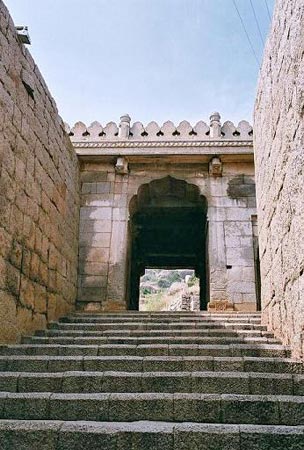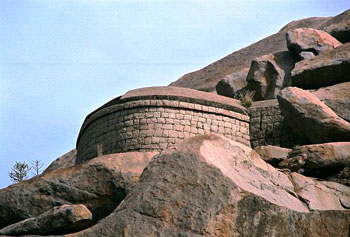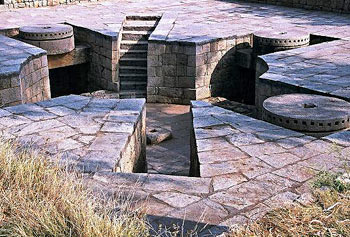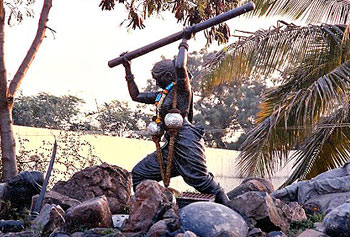
Kannada naa dina veera ramaniya gandu bhuumiya veera naariya cariteya naanu haaduve (I sing the chronicles of a brave queen belonging to the brave, charming and masculine land of Kannada!)
These lines from a song from the 1972 Kannada movie Nagara Haavu remind every soul in Karnataka of the stone/ rock fort of Chitradurga, the glory of its Nayakas and the brave Obavva, whose deeds of valour are sung even to this day.
Part of the Vedavati River valley, with the Tungabhadra flowing in the north-west, Chitradurga is situated approximately 240 km from Bengaluru in Karnataka on the Bengaluru-Pune national highway.
The name Chitradurga was derived from an umbrella-shaped hill called Chitrakaldurga. The hills on which a major part of the fort and the city rest belong to the oldest rocks of granite formation in the country. The history of the city can be traced back to the epic Mahabharata. Legend says that Hidimbasura, a man-eating giant lived on the Chitradurga hill, which was then known as Hidimbavana. Hidimba's duel with Bhima, where the former was killed, happened on this hill, and it is believed that the large boulders found on the hill were used during the duel.

Citradurgada kallina kote sidiligu beccada ukkina koote (Chitradurga had a stone fort. It wouldn't budge even to thunderbolt, this steely fort!)
Chitradurga fort is often referred to as Kallina Kote (stone fortress) and Ukkina Kote (steel fortress), signifying that the fort was impenetrable.
The most noticeable feature of the fort is that no cementing material was used to join the large block of stones that form the seven walls of the fort. These walls also give it the name Yelu Suttina Kote (fort of seven walls) in Kannada.

The fort consists of 19 gateways, 38 posterior entrances, secret entrances, four invincible passages, watchtowers, water tanks, oil pits, storage warehouses, a palace and quite a few temples including those dedicated to Hidimbeswara, Gopalkrishna, Subbaraya, Phalguneswara, Sampige Siddeshwara, Ekanatheshwara, Nandi and Uchangi Yellamma, the principal deity of the Nayaka Pallegars.
The four main gateways -- Rangayyana Bagilu on the east, Ucchangi Bagilu on the west, Siddayyana Bagilu on the north and Lalkote Bagilu on the south are located on the outer walls of the fort.

One of the most fascinating structures is a quadruple mill called Maddu Bisuva Kallu (gun powder grinding stone). It has four huge grinders that were rotated by elephants or bullocks.

Another structure, which stands on top of the hill is the Muruga Matha, built in honour of a renowned guru of the Veershaivas (also known as Lingayats, they are followers of the teachings of Basavanna, a 12 century philosopher).
The Nayaka King's advisor was the chairperson of the Murughi Matha and it is said that Bharamappa Nayaka built this Matha in honour of Immadi Murugharajendra Swami (8th chairperson) as it was under his blessings that Bharamappa Nayaka was coronated. After the fall of the Nayakas, the Matha fell in ruins, and has now been shifted to a new location on the Chitradurga-Davangere road.
The Tanniru doni (cold water boat) a small water source which is said to hold cold water through the year and the Akka Thangiyara Honda (sisters' pond) are other locations of interest.

Madisida kariya madava Dagisida madakari naayakaraalida koote (This fort was ruled by Madakari Nayakas who tamed intoxicated elephants)
Chitradurga was ruled by a number of rulers including the Chalukyas, Hoysalas and the Vijayanagar Empire before the Nayakas came into power. The Nayakas took independent control of the region after the fall of the Vijayanagar Empire in 1565 and ruled for more than 200 years till Madakari Nayaka V was defeated by Hyder Ali in 1779.
Timmana Nayaka, was appointed a chieftain and later governor under the Vijaynagar Empire before taking over the region. He was succeeded by his son Obana Nayaka (1588-1602) also known as Madakari Nayaka. Legend has it that when an intoxicated elephant went on a rampage, Obana Nayaka, completely unarmed, got hold of the elephant's trunk and tamed it. Hence he got the name Madakari Nayaka.

Koteyu salahida tayi (The Fort counselled a Mother)
The brave deed of Obavva during one of the wars raged by Hyder Ali has earned her a place in the history of Chitradurga. According to legend, Obavva, wife of a soldier, was substituting for her husband who was taking a lunch break when she heard muffled sounds of enemy soldiers trying to enter the fort through a small crevice. She hid near the entry with an onake, or pestle and hit each soldier who attempted to enter the fort.
Her husband returned to find her standing with a blood stained onake in her hand and several dead enemy soldiers around her. She was immortalized as Onake Obavva, and the crevice through which enemies entered is now called Onake Obavvana Kindi. To mark her brave act, Obavva's statue has been erected in front of the district commissioner's office in Chitradurga.
Obavva joined the ranks of the great heroines of Indian history like Rani Lakshmibai of Jhansi and Rani Chennama of Kittur with her selfless act. Chitradurga is a land of some of the greatest heroes of Karnataka and the fort still stands strong today, a testimony to the timeless glory of the Nayakas.